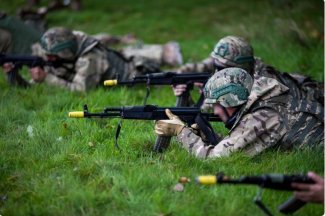Extension of the EU training mission. Day 992 of the war


Russian forces have penetrated a Ukrainian grouping to the north-west and south of Kurakhove, with the result that the Ukrainian troops are in danger of being cut off. The Russians have damaged the causeway on the Kurakhove Reservoir, which, if ruptured, may result in the flooding of the defenders’ main supply route (so far the water level in the Vovcha is expected to rise by 1.2m). Russia is continuing the assault west of Selydove, resulting in the progressive flanking of Pokrovsk from the south.
The Russians have resumed their assault on the border of the Donetsk and Zaporizhzhia oblasts south-west of Velyka Novosilka, reoccupying places recaptured by the enemy during the 2023 summer offensive. The Ukrainian command expects a new strike in Zaporizhzhia Oblast, supported by Russia’s reinforcement of the grouping there and intensified attacks on its positions south-west of Orikhiv.
Russia pushed Ukrainian forces out of more settlements in the Kursk Oblast, but this did not affect the overall situation. Russian advances on other lines of operation in the Donbas and Kharkiv Oblast have also failed to make any significant difference.
On 10 November, Russia attacked with a record 145 Shahed/Geran drones. From the evening of 5 November until the morning of 12 November, a total of 641 thought to have been used. 353 drones are thought to have been destroyed and 246 were declared locally lost, which Kyiv said could be due to the impact of radio-electronic warfare systems. At the same time, 22 missiles are thought to have hit targets in Ukraine, with Ukraine claiming to have shot down six. Half of the drones used by the Russians are said to be low-cost decoys without any part of the equipment or warhead, whose main purpose is to deplete Ukraine’s air defences. According to the head of Ukraine’s Centre for Countering Disinformation, the effectiveness of enemy attacks using drones is just over 10%. Russia is said to be stockpiling numerous cruise missiles at strategic aviation bases, indicating that another major missile attack is imminent.
The main target of Russian missile and drone strikes was Odesa and its surroundings. This city was attacked daily from 7 to 10 November. Damage to energy infrastructure facilities occurred in Mykolaiv Oblast (6 November) and Zhytomyr Oblast (7 November). Destruction was also reported in Kyiv (7 November) and Mykolaiv and Kryvyi Rih (11 November). Kharkiv, attacked daily from 8 to 11 November, remains the most frequent target of directed aerial bombs (Russian: KAB). Twice (7 and 11 November) KABs hit Zaporizhzhia.
On 6 November, Ukrainian drones attacked the Russian Navy base in Kaspiysk for the first time. Although they caused no damage, the surprise strike disrupted work at the base for the Russians. The attacks carried out over the following days also failed to cause major damage, with targets including a refinery in Saratov (8 November), a chemical plant in Alexin in Tula Oblast (9 November) and an ammunition depot in Bryansk Oblast (10 November). On 10 November, the Ukrainians are also thought to have launched one of their largest attacks on Moscow Oblast. According to Russian sources, 34 drones were shot down over it. In total, at least 84 Ukrainian drones are thought to have hit targets in Russia on that day.
On 8 November, the EU Council decided to extend the mandate of the EUMAM military mission for a further two years – until 15 November 2026. The budget for the project envisages the disbursement of €409 million. To date, some 63,000 Ukrainian soldiers have been trained on EUMAM premises. A further 15,000 will be trained in the coming months. Continuing to help train the local military is one of the points of a separate security agreement that Ukraine concluded with the EU in June this year. In August this year, EU defence ministers decided not to move the training of the Ukrainian army onto Ukrainian territory, instead opting to take it as close to Ukraine’s borders as possible.
On 12 November, Ukrainian Defence Minister Rustem Umerov announced that his ministry had signed a contract with the Finnish company ICEYE, which offers access to satellite imagery accurately depicting the Earth’s surface. The Ukrainian military will receive photographs covering the ‘full area of warfare’ and will be able to designate priority observation zones on their own. ICEYE’s cooperation with Ukraine was established back in August 2022, when the Serhiy Prytula Foundation, which supports the army there, was granted access to one of the satellites.
Reuters reported on 8 November that President Joe Biden’s administration is expected to approve the participation of US specialists in the servicing and refurbishment of armaments on Ukrainian territory. This is to include F-16 fighter jets and Patriot air defence systems. The US is another country that has decided to send its specialists to Ukraine. The forerunners in this regard were Poland and the UK.
On 8 November, the Pentagon announced that it intended to use funds allocated in military support programmes for Ukraine by the end of the incumbent president’s term (20 January 2025). There was $4bn to be used to cover equipment and ammunition transferred from US Army depots (under the Presidential Drawdown Authority, PDA) and $2bn for industry procurement (under the Ukraine Security Assistance Initiative, USAI). A day later, The Wall Street Journal reported that Kyiv will receive more than 500 interceptor missiles for the Patriot and NASAMS systems by the end of the year. It will also receive ten SCALP cruise missiles, as announced by French Defence Minister Sébastien Lecornu on 10 November.
On 11 November, the Ministry of Strategic Industries of Ukraine said that local manufacturers of drones, anti-tank guided missiles and artillery will receive €535 million from a Danish support programme by the end of the year. The funds are to come not only from Denmark – the main donor – but also from Sweden and from interest on frozen Russian assets.
15 HAWK air defence systems from Taiwan were due to arrive in Ukraine, according to a 12 November report of the Forbes magazine. It also stated that the government in Taipei tried to keep the event secret.
On 6 November, the spokesperson for the General Staff of the Ukrainian Armed Forces, Dmytro Lykhoviy, announced that the Russian forces involved in the aggression against Ukraine had recently increased their numbers by almost 100,000 men, and that the front line was already 1,300 km long. In order to effectively oppose the enemy, the Ukrainian side continues to create new brigades within the armed forces but, faced with the risk of breaking the defence line, it is also forced to redeploy battalions to the front which are part of units not involved in the fighting. He stressed that the army does not currently have the capacity to quickly replenish the new brigades with well-trained soldiers.
Ukrainian law enforcement agencies are reporting further cases of the occurrence of corruption to avoid conscription. On 6 November, the head of one of the military commissions and the deputy commander of a territorial defence brigade were detained in Zakarpattia Oblast. They offered to issue documents confirming ineligibility for service or removal from the register for $4,000–6,000.
On 7 November, Prime Minister Denys Shmyhal, commenting on the mobilisation exercise, pointed out that 98% of calls for military service are received by men who cannot show proof of employment and payment of income tax.
On 9 November, Commander-in-Chief of the Armed Forces of Ukraine General Oleksandr Syrskyi, in a conversation with Commander of the US Forces European Command Christopher Cavoli, stated that the situation on the front remains difficult and trending towards deterioration. The enemy, using its numerical superiority, is continuing offensive operations and concentrating its main efforts on the Pokrovsk and Kurakhove directions. He added that the Ukrainian side has information on the preparation of North Korean soldiers to participate in hostilities alongside Russia.
On 9 November, the Ukrainian defence ministry confirmed that, since the beginning of the year, the Defence Procurement Agency has signed contracts and paid advances for the purchase of long-range drones worth 20 billion hryvnias (about $0.5 billion). Five Ukrainian companies have been awarded long-term contracts for the production of drones with a range of more than 1,000 km.
On 7 November, President Volodymyr Zelensky stated that there were 11,000 North Korean troops on Russian territory, including in the Kursk Oblast. Some of them took part in combat operations against the Ukrainian army and suffered losses. On 11 November, commenting on the situation on the frontline, he stated that there were around 50,000 men in the grouping of Russian troops in the Kursk Oblast.





